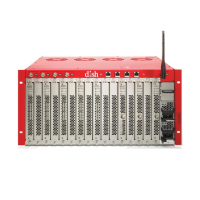40
Transport Stream Format
The transport stream format must be a SPTS with a valid PAT and PMT. This means that the PAT (which is on PID
0) properly references one and only one PMT and the PMT references all the PIDs in the stream as ES PIDs or CA
PIDs through the CA descriptor. In addition, the PMT properly identifies the PCR PID and this PCR PID is one of the
identified ES PIDs.
The content of the PIDs specified in the PMT is not constrained by this specification and can thus contain, video,
audio, data, ECMs,etc. The PIDs can also contain scrambled data.
No other stream information will be processed outside of the PAT and PMT which means that DVB SI, ATSC PSIP,
or other private signaling is ignored.
PIDs
There are no restrictions on the usage of PIDs as long as they meet the MPEG-2 requirements as defined in above
(i.e. PAT is on PID 0 and no other data is on PID 0). A maximum of 15 PIDs (both ES and CA) are supported in the
PMT.
Timing/PCRs
The supplied PCR values in the stream must be consistent and meet the MPEG-2 specification above. If the
supplied IP input service is a video that is repeated such that there are wrap points from the end to the beginning,
then the time PCRs shall be continuous across this wrap point or this could result in a service interruption in the
output. Inconsistency in the PCRs also could result in service interruption in the output.
Continuous Video and Audio
If the IP input source is a repeated video stream (e.g. from a file), then the audio/video stream should be created
such that the end to beginning transition is smooth. If not, it is likely that the TV (video decoder) will exhibit
artifacts. Creating a smooth transition for video can be accomplished with either of the following:
• Ensure the video starts with a proper reference frame (IDR for H.264 or I for MPEG-2) and create a closed
GOP at the end of the video and ensure the video ends at the closed GOP
• Fade to black at the beginning and end of the stream for several seconds so that the end matches the
beginning and any video references between the end and the beginning wrap point are the same. Also,
ensure that the stream starts with a full valid encoded frame and ends with a full valid encoded frame.
For audio, a smooth transition is accomplished by muting the audio for several seconds at the beginning and end
of the stream. In addition, the beginning of the stream should start with a complete audio encoding block, and the
end of the stream should have a complete audio encoding block.
If the IP streaming mechanism can also ensure that the PCR and PTS values in the stream are updated
continuously (even at the wrap point), then SMARTBOX and the receiving TV/STB will not have any interruptions in
the service at the end to beginning transition due to timing discontinuities.

